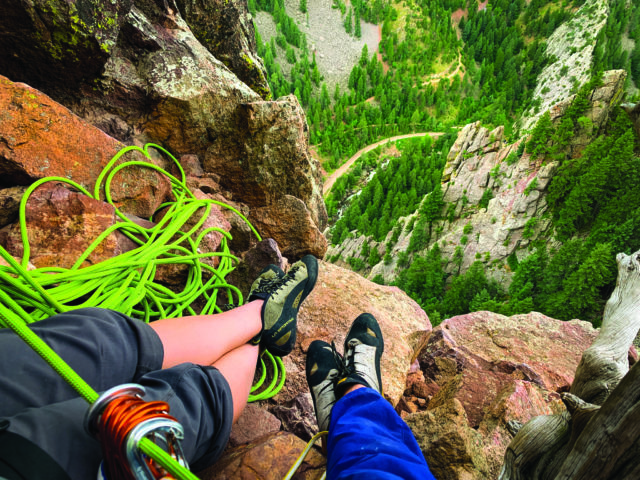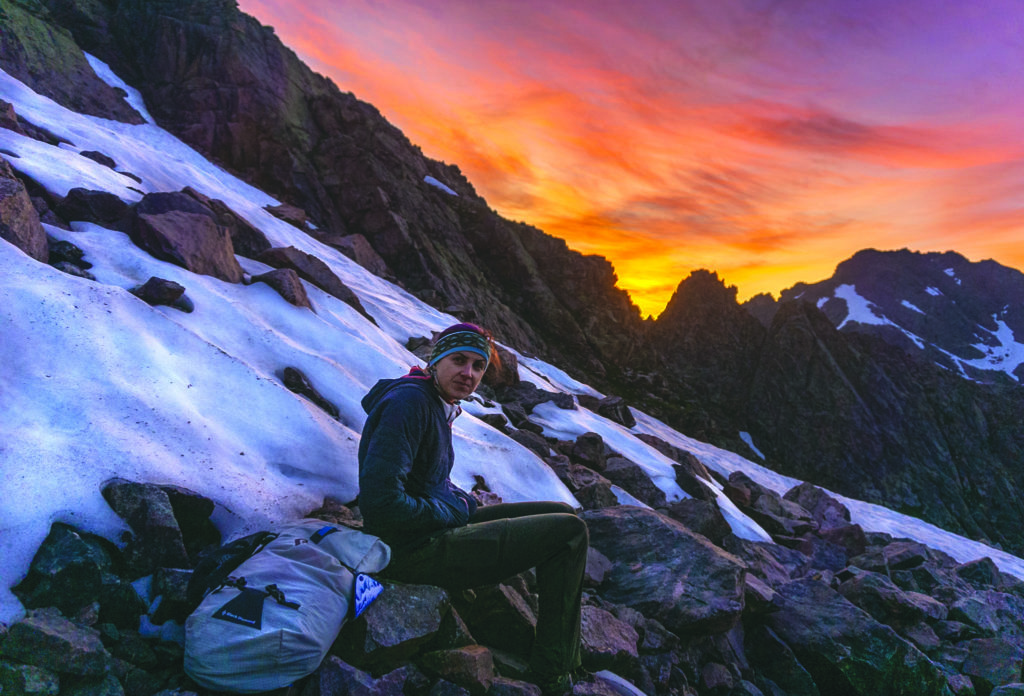
My hand slipped from the hold. I peeled away from the rock and watched as my alpine draw engaged, unexpectedly extended and snapped away from my waist.
That’s not right, I thought as a surge of panic welled up inside me. You’re going to hit the ground now. I tumbled helplessly like a rag doll over boulders for 25 feet, screaming until my body finally came to a halt.
In an instant I watched my belayer, John (also my fiancé), fly up over a boulder, and I braced myself, preparing to get yanked by him over yet another cliff. But nothing happened. Dazed and confused I sat up, searching for pools of blood and bones sticking out of my body. Somehow I had managed to fall 25 feet and walk away with some bad scrapes and a few bruised bones.
Dumbstruck, I began to go into preservation mode as the adrenaline surged and nearby climbers poured over John and me like ants on a popsicle. I rubbed anti-septic wipes on my wounds while a fellow climber wrapped my ankle. It could hardly take much weight, and I fretted over the pain that would set in as the adrenalin wore off. A few climbers helped John and me hobble down the eroded climber’s trail to our vehicle. Shell-shocked but alive, we drove home.
Five years ago, I decided to start rock climbing. Even though most outings ended in tears and panic attacks, I continued to come back to the sport. There was something about pushing past my fear of heights that kept calling me back. Eventually I worked through the panic and innate fear of hanging by a rope in high places. I became a multi-pitch trad climber and soared to new heights. I climbed in the alpine and swung leads on classic 600-plus-foot climbs around the country. One day I found that I not only felt like a confident climber, but that self-assurance had trickled into my everyday life as well.
After the fall, I saw all of that progress slip away, tumbling alongside me in that freak accident. I refused to accept that reality. The first thing I wanted to do after I fell was to jump right back on the route. It was as if some type of protective instinct overcame me: I simply had to keep climbing.
Stubbornly, I tucked my emotions away and relegated the flashes of trauma from the incident to the far corners of my mind. I couldn’t let this accident undermine the countless years of mental work I had put in to get to where I was. This won’t happen to me; I repeated that mantra again and again as 11 hand-sized bruises and scabs kept me from sleeping at night.
After X-rays revealed that I hadn’t broken any bones, I made plans to get back out on the sharp end. Just five days after falling, I decided to head up to Eldorado Canyon and climb Rewritten, a 600-foot classic, moderate trad climb that is highly exposed. The climb was right at my ability, and in my mind it represented grit.
As I stepped up onto the rock, my wounds felt fresher than I would’ve liked. The signature unstable sections of rock immediately gave me flashbacks. I gritted my teeth through the climb and focused on the close friend I was with. As I topped out, my nerves were frayed. I just couldn’t stomach being roped up, but I couldn’t admit that I was mentally suffering. This won’t happen to me I repeated, my palms slick with sweat.
Over the next few weeks I carried on with my objectives for the season, trying to scramble new routes in the alpine and climbing granite in California. I did so despite the nagging feeling that the outdoors had betrayed me. It terrified me.
As I struggled through each activity, I kept telling myself that nothing traumatic had happened to me — both of us walked away, after all. There have been many more serious accidents on the rock, many of which didn’t end as well as mine. Instead of feeling depressed, I should feel grateful. I just kept telling myself: This isn’t happening to me.
Most of my outings left me feeling raw. I frustratingly backed down from summits, moving much slower than years past. I couldn’t help but look down from an exposed ledge and picture each way my body could bounce toward the bottom.
Even climbing in the gym left my stomach knotted from the anxiety. I remember belaying my fiancé on a super-easy warm-up and picturing him falling off of the plastic holds to his death.
What had once been my source of strength left me feeling weak, vulnerable and incapable. Slowly, I felt myself slip away into a depression. The places that once left me feeling awe-struck and empowered were now sources of fear and trauma. Every moment I wasn’t outside I felt like I was missing out, but my motivation to climb waned to an all-time low.
I tried to remain open to the notion that the feelings from the fall were temporary, but I couldn’t accept that I was now afraid of the places I loved the most. The strength I had once found on the wall felt a million miles away, like a fleeting memory. Through it all, I never shed a single tear. I was unable to accept the trauma that came with falling.
The house of cards came crashing down a month after the fall. I turned around on a mountainside after a 16-foot strip of sloping; solid ice stopped me in my tracks. Without proper ice climbing gear, the route wasn’t safe. I stood there frustrated and let down.

My fiancé turned to me and said, “I’m proud of you; you’re making safe decisions even when it isn’t easy.” I smiled weakly, knowing that he was right, but still fighting the gnawing depression and self-criticism. As the sun rose over the rock, I tried to focus on the moment instead of the climb. It was a temporary band-aid; I knew I couldn’t hold back the tsunami of emotions headed my way.
“I never want to hear you scream like you did that day again,” John said. “One wrong step here and you would most certainly die, or wish for it when you stopped moving.” I nudged a loose piece of rock and watched it tumble down 800 feet of exposed, steep scree. I knew he was right. I looked at him as I fought back tears. It wasn’t quite time yet, so I refocused on the sunrise.
Back home, I finally let myself feel a month’s worth of pent up emotional pain. I wept. When I thought I was finished, I wept again. I felt lonely. But instead of fighting through it like I’d made a habit of doing, I just let the emotions wash over me, again and again.
It was time to face the reality that even though I walked away with nothing but a few scars, I had stared death in the face while doing the activity that brings me the most strength. Climbing gives me a sense of place where I feel truly connected to my purest self. It’s just me, the rock and my thoughts — nothing else matters. After years of building up that trust, I had to admit that the trust was bent, maybe even broken for a little while.
I can’t say that there was an “ah-ha” moment where everything magically got better. In fact, I’m not even sure that I am doing better. But I am out on the rock, and that’s what matters.
For better or worse, tumbling off the climbing route changed me. How I approach a climb and what I’ve gained from climbing is changing. Every day is different and I’m never certain what my mind will uncover.
The rock is a brutally honest friend. She’s the kind of friend that won’t let you hide behind a façade and doles out frank advice, plain and simple. If you choose to ignore it, she’ll scream until it’s the only thing you hear.
The sport of climbing is addictive. It becomes an all-consuming obsession and begins to feel like a drug. You need it, but you don’t always want it, thanks to the emotions it both masks and brings to the surface.
It’s hard to not get frustrated when things change in ways we didn’t expect. We can’t just bottle up the worst parts of our lives and stick them in a mental closet.
In order to move on and find ourselves again, we have to turn into the things that terrify us. Facing fear has always been at the heart of why I took up climbing, and now that fear is a little more complicated. Just as I began to grasp the concept of strength over fear, the fear changed, leaving me vulnerable.
If there’s anything I’ve learned from the accident, it’s that allowing yourself to be vulnerable is the ultimate form of strength. It is only through vulnerability that we can truly overcome fear. Through that vulnerability, we enable ourselves to grow in ways we never thought possible.














